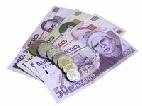
 |
|
| Financial Terms | |
| job order cost sheet |
|
Information about financial, finance, business, accounting, payroll, inventory, investment, money, inventory control, stock trading, financial advisor, tax advisor, credit.
Main Page: stock trading, financial, business, accounting, inventory control, inventory, money, finance, Also see related: home, homebuyer, home financing, real estate, home buyer, property, first time homebuyer, homebuying, homes, |
Definition of job order cost sheet
job order cost sheeta source document that provides virtually
Related Terms:job cost recordsee job order cost sheet Accelerated cost recovery system (ACRS)Schedule of depreciation rates allowed for tax purposes. Agency cost viewThe argument that specifies that the various agency costs create a complex environment in Agency costsThe incremental costs of having an agent make decisions for a principal. All-in costTotal costs, explicit and implicit. Average cost of capitalA firm's required payout to the bondholders and to the stockholders expressed as a Balance sheetAlso called the statement of financial condition, it is a summary of the assets, liabilities, and  Balance sheet exposureSee:accounting exposure. Balance sheet identityTotal Assets = Total Liabilities + Total Stockholders' Equity Bankruptcy cost viewThe argument that expected indirect and direct bankruptcy costs offset the other Buy limit orderA conditional trading order that indicates a security may be purchased only at the designated Carring costscosts that increase with increases in the level of investment in current assets. Cost company arrangementArrangement whereby the shareholders of a project receive output free of Cost of capitalThe required return for a capital budgeting project. Cost of carryRelated: Net financing cost Cost of fundsInterest rate associated with borrowing money.  Cost of lease financingA lease's internal rate of return. Cost of limited partner capitalThe discount rate that equates the after-tax inflows with outflows for capital Cost-benefit ratioThe net present value of an investment divided by the investment's initial cost. Also called Cross-border riskRefers to the volatility of returns on international investments caused by events associated Day orderAn order to buy or sell stock that automatically expires if it can't be executed on the day it is entered. Economic order quantity (EOQ)The order quantity that minimizes total inventory costs. Equivalent annual costThe equivalent cost per year of owning an asset over its entire life. Execution costsThe difference between the execution price of a security and the price that would have Fill or kill orderA trading order that is canceled unless executed within a designated time period. Financial distress costsLegal and administrative costs of liquidation or reorganization. Also includes Fixed costA cost that is fixed in total for a given period of time and for given production levels.  Friction costscosts, both implied and direct, associated with a transaction. Such costs include time, effort, Incremental costs and benefitscosts and benefits that would occur if a particular course of action were Information costsTransaction costs that include the assessment of the investment merits of a financial asset. Limit orderAn order to buy a stock at or below a specified price or to sell a stock at or above a specified Limit order bookA record of unexecuted limit orders that is maintained by the specialist. These orders are Market impact costsAlso called price impact costs, the result of a bid/ask spread and a dealer's price concession. Market orderThis is an order to immediately buy or sell a security at the current trading price. Market timing costscosts that arise from price movement of the stock during the time of the transaction Negotiable order of withdrawal (NOW)Demand deposits that pay interest. Net financing costAlso called the cost of carry or, simply, carry, the difference between the cost of financing Off-balance-sheet financingFinancing that is not shown as a liability in a company's balance sheet. Open (good-til-cancelled) orderAn individual investor can place an order to buy or sell a security. That Opportunity cost of capitalExpected return that is foregone by investing in a project rather than in Opportunity costsThe difference in the performance of an actual investment and a desired investment Pecking-order view (of capital structure)The argument that external financing transaction costs, especially Price impact costsRelated: market impact costs Replacement costcost to replace a firm's assets. Round-trip transactions costscosts of completing a transaction, including commissions, market impact Search costscosts associated with locating a counterparty to a trade, including explicit costs (such as Sell limit orderConditional trading order that indicates that a, security may be sold at the designated price or Shortage costcosts that fall with increases in the level of investment in current assets. SpreadsheetA computer program that organizes numerical data into rows and columns on a terminal screen, Stop-loss orderAn order to sell a stock when the price falls to a specified level. Stop order (or stop)An order to buy or sell at the market when a definite price is reached, either above (on a Stop-limit orderA stop order that designates a price limit. In contrast to the stop order, which becomes a Sunk costscosts that have been incurred and cannot be reversed. Trading costscosts of buying and selling marketable securities and borrowing. Trading costs include Transactions costsThe time, effort, and money necessary, including such things as commission fees and the True interest costFor a security such as commercial paper that is sold on a discount basis, the coupon rate Variable costA cost that is directly proportional to the volume of output produced. When production is zero, Weighted average cost of capitalExpected return on a portfolio of all the firm's securities. Used as a hurdle BALANCE SHEETA “snapshot” statement that freezes a company on a particular day, like the last day of the year, and shows the balances in its asset, liability, and stockholders’ equity accounts. It’s governed by the formula: Cost basisAn asset’s purchase price, plus costs associated with the purchase, like installation fees, taxes, etc. Cost of goods soldThe cost of merchandise that a company sold this year. For manufacturing companies, the cost of raw MACRS (Modified Accelerated Cost Recovery System)A depreciation method created by the IRS under the Tax Reform Act of 1986. Companies must use it to depreciate all plant and equipment assets installed after December 31, 1986 (for tax purposes). Absorption costingA method of costing in which all fixed and variable production costs are charged to products or services using an allocation base. Activity-based costingA method of costing that uses cost pools to accumulate the cost of significant business activities and then assigns the costs from the cost pools to products or services based on cost drivers. Avoidable costscosts that are identifiable with and able to be influenced by decisions made at the business Balance SheetA financial statement showing the financial position of a business – its assets, liabilities and Cash costThe amount of cash expended. CostA resource sacrificed or forgone to achieve a specific objective (Horngren et al.), defined Cost behaviourThe idea that fixed costs and variable costs react differently to changes in the volume of Cost centreA division or unit of an organization that is responsible for controlling costs. Cost controlThe process of either reducing costs while maintaining the same level of productivity or maintaining costs while increasing productivity. Cost driverThe most significant cause of the cost of an activity, a measure of the demand for an activity Cost objectAnything for which a measurement of cost is required – inputs, processes, outputs or responsibility centres. Cost of capitalThe costs incurred by an organization to fund all its investments, comprising the risk-adjusted Cost of goods soldSee cost of sales. Cost of manufactureThe cost of goods manufactured for subsequent sale. Cost of qualityThe difference between the actual costs of production, selling and service and the costs that would be incurred if there were no failures during production or usage of products or services. Cost of salesThe manufacture or purchase price of goods sold in a period or the cost of providing a service. Cost-plus pricingA method of pricing in which a mark-up is added to the total product/service cost. Cost poolThe costs of (cross-functional) business processes, irrespective of the organizational structure of the business. Cost–volume–profit analysis (CVP)A method for understanding the relationship between revenue, cost and sales volume. Direct costscosts that are readily traceable to particular products or services. Fixed costscosts that do not change with increases or decreases in the volume of goods or services Full costThe cost of a product/service that includes an allocation of all the (production and Indirect costscosts that are necessary to produce a product/service but are not readily traceable to particular products or services – see overhead. Job costingA method of accounting that accumulates the costs of a product/service that is produced either Labour oncostThe non-salary or wage costs that follow from the payment of salaries or wages, e.g. National Lifecycle costingAn approach to costing that estimates and accumulates the costs of a product/service over Marginal costThe cost of producing one extra unit. Opportunity costThe lost opportunity of not doing something, which may be financial or non-financial, e.g. time. Period costsThe costs that relate to a period of time. Prime costThe total of all direct costs. Process costingA method of costing for continuous manufacture in which costs for an accounting compared are compared with production for the same period to determine a cost per unit produced. Product costThe cost of goods or services produced. Relevant costThe cost that is relevant to a particular decision – future, incremental cash flows. Semi-fixed costs costs that are constant within a defined level of activity but that can increase or decrease when Semi-variable costscosts that have both fixed and variable components. Standard costsA budget cost for materials and labour used for decision-making, usually expressed as a per unit cost that is applied to standard quantities from a bill of materials and to standard times from a Sunk costscosts that have been incurred in the past. Related to : financial, finance, business, accounting, payroll, inventory, investment, money, inventory control, stock trading, financial advisor, tax advisor, credit. |